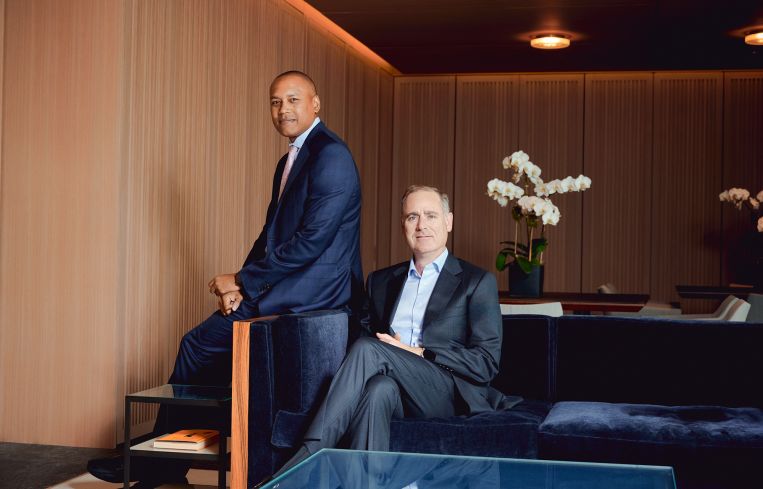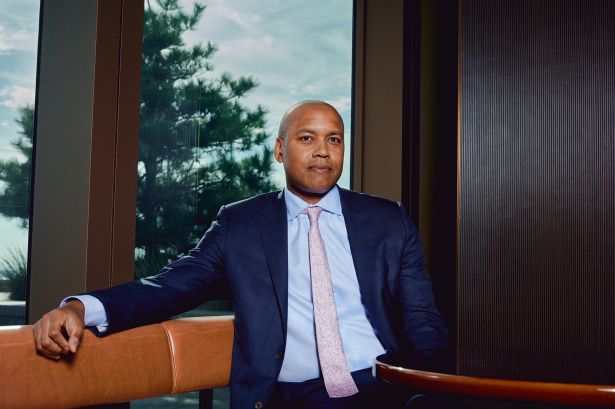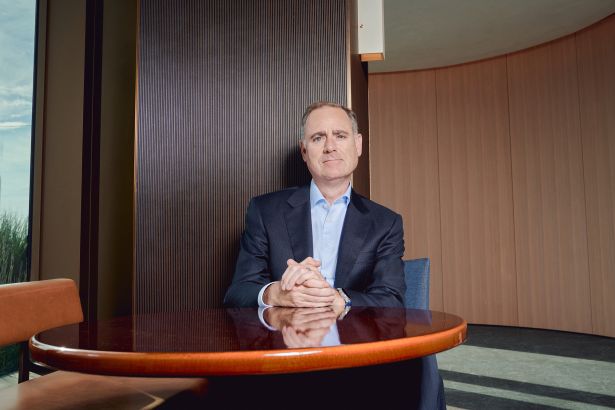How Chris Lee and Matt Salem Scaled KKR’s Real Estate Credit Business
An original $400 million in seed money has grown to $43.2 billion in assets under management in the past 10 years
By Cathy Cunningham October 7, 2025 2:00 pm
reprints
Pythagoreans consider the number 10 a sacred number, one of perfection that embodies the completeness of something. While the number also represents an important milestone for KKR’s real estate credit business, the investment firm is far from done (sorry, Pythagoreans). On the contrary, it’s just getting started.
First, let’s reflect on how far it’s come, by the numbers.
Since its inception in 2015, KKR’s real estate credit business has grown from a $400 million seed investment and 10 employees to $43.2 billion in assets under management (AUM) and 110 professionals in the U.S. and Europe. It’s also the largest third-party purchaser of commercial mortgage-backed securities (CMBS) B-pieces in the U.S. today.
So, pretty darn far.
It’s also become a household name in commercial real estate finance circles — although it didn’t always have borrowers lining up at the door.
“When we started the real estate credit business back in `15, we had a really small team,” said Chris Lee, president of KKR’s global real estate business. “The first few loans we made, we had to — beg would be a strong word — but we had to strongly convince people to let us lend them money.”
Lee remembers conversations with potential borrowers at the time and the fears that had to be quelled by him saying, “Yes, we will be here. Yes, we will have the capital, and we will close!”
KKR headed south for its first loan origination in 2015, making a $55 million whole loan for the acquisition of an office property in Nashville, Tenn.
“Now, we’re running this much bigger business, and I give Matt a lot of credit in bringing it all together,” Lee said, referring to Matt Salem, a partner and head of real estate credit at KKR. “Running a business where you’re making 10 loans a year is very different from running a business where you’re making a loan every week.”
Indeed, in the 12 months ending June 2025 alone, KKR’s loan originations totaled $5.6 billion across 46 deals, and it invested $4 billion in real estate securities, and the team’s efforts over the past decade have led to the real estate credit business accounting for more than half of KKR’s $80 billion total global real estate AUM today.
Rewinding back
The real estate credit practice was built block by block. But first, the right team had to be put in place.
Lee joined KKR in 2012 from Apollo Global Management, and was tasked with figuring out what the next iteration of the firm’s real estate business should look like. When the decision was made that the way forward was to be a provider of both equity and debt, and Lee brought Salem and nine of his colleagues from Rialto Capital in to lead the charge.
Having a fully integrated debt and equity platform at KKR was always key, Lee said.
“A lot of us have worked in different places where that integration wasn’t necessarily apparent,” Lee said. “We knew we could be much more powerful if we had the equity business and the credit business sitting adjacent to each other, sharing a lot of the same resources, sharing a lot of the same thematic work around where and how to invest, and then having the risk priced by the same investment committee.”
“We also wanted it to overlap as much as possible with the equity business, in terms of the quality of real estate and the markets that we’re in,” Salem added. “So, to some extent, we had a little bit of a playbook there, but now we’ve expanded it for credit and broadened our range while still really focusing on the areas where we’ve had success and experience on the equity side. I think that’s translated into a very institutional product where we’re lending on very high-quality real estate.”
KKR’s credit business was focused on lending to other firms that looked a lot like it did on the real estate equity side of its business — in other words, large, sophisticated sponsors. By default, the loans it started making were also on the larger side.
“We had a credit box in mind and an investment thesis in mind, and that really shaped where the business was ultimately going to go over time,” Salem said.
Putting those building blocks in place also happily coincided with a tangible market opportunity for nonbank lenders at the time.
“We were still coming out of the GFC, in some ways, at that point,” Salem said, referring to the Global Financial Crisis. “Banks were continuing to pull back, and we had this thesis that private capital would take more market share over time — that’s certainly what happened, and, 10 years later, it’s still happening.”
Jumping in the deep end
KKR started out with two debt-focused strategies: KKR Real Estate Finance Trust (KREF) — a real estate investment trust (REIT) that originated senior commercial mortgages and was taken public in 2017 — and KKR Real Estate Credit Opportunity Partners (RECOP), which purchased junior tranches of CMBS. But one of the keys to KKR’s success over the years has been its decision to further diversify its range of capital to now include eight pools, including bank, insurance, mortgage REIT and debt fund capital.
Critically, given that the market has had more peaks and valleys than Yosemite these past five years, each pool has the ability to be turned on and off depending on market needs and wants.
Its diversification of capital has also allowed KKR to remain in the market regardless of bumps, and in the process deepened its relationships with the borrowers it serves.
“Borrowers say, ‘You have all these products. Here’s what we need. What can you do?’ ” Salem said. “We have a lot of flexibility within each pool of capital to create the right solution for them. It’s pretty neat when we can send a term sheet to our clients and you have three different bids laid out [from different pools].”
Not that it happens on every deal. Sometimes, for example, borrowers want only a fixed-rate loan, or sometimes they want only a certain leverage point. When it works, though, it works.
“When we can put it all together, we’ll hear borrowers say, ‘Oh, this is pretty interesting, I’ve got this menu from one firm that can offer many things.’ ” Salem said.
Insurance capital — patient and stable — was particularly in demand the past couple of years, and KKR was ready. A huge moment, and point of acceleration for KKR’s credit business, came in its acquisition of insurance company Global Atlantic.
Global Atlantic was founded at Goldman Sachs in 2004 as the firm’s reinsurance group before separating off and becoming an independent company in 2013. KKR acquired a majority stake in the company in 2020, then acquired the remainder of the company in 2024.
Since it was announced that KKR was acquiring the original stake, Global Atlantic’s assets under management have almost tripled to a staggering $201 billion.
“That acquisition really took us from having one core product, debt fund product, to us having a much different scale and reach in the business,” Lee said. “It changed how we were thought of as a brand, from lending $3 billion a year to $10-plus billion a year. It took a lot to integrate that and make sure we had the processes and procedures to just run a much higher volume business, going from 15 loans a year to 50 loans a year. But, once that integration was completed, our franchise and the brand recognition was just totally different.”
The acquisition came about in the form of a business meet-cute. KKR was interested in adding insurance capital to its business, while Global Atlantic had grown to the point where it needed larger investment teams to help scale its business. Et, voilà. Further, and importantly, there were several cultural consistencies between the two platforms and a shared strategic vision.
“Each of us were in the right place to try to grow,” Salem said. “Global Atlantic has met and exceeded every expectation of ours, and we’re still on that journey. It’s been really exciting to be a part of that business and help the growth there.”
While there are no other big acquisitions in the works (or at least none that Lee and Salem would tell a pesky reporter about), there’s plenty of runway for growth. That includes an expansion on the insurance capital side.
“In being a part of an investment management business, there’s natural growth through fund series. We’ll continue to grow as we go from fund two to fund three, which will then allow us to do more — and larger — deals,” Salem said. “To date we’ve been very focused on our own insurance capital, and we haven’t expanded that product to include other insurance companies, but we’ve been asked to do that over the years. We’re excellent at investing our own insurance capital, and a potential growth area for us is to supplement or add on insurance capital alongside what we’re doing in our own insurance company.”
Other potential areas of growth include wealth channels — accessing the affluent or mass affluent — and infrastructure.
With the latter, “We’re thinking about ways that we can use our broader ecosystem and expertise to lend on things that look more like infrastructure than real estate,” Salem said.
If data centers are coming to mind right now, you’re not alone (and you work in real estate).
“Data centers can show up in a lot of different ways,” Salem said. “The firm will approach those opportunities depending on the form in which they show up. We certainly invest that in our asset-backed securities (ABS) business, because we issue bonds for ABS, we invest in them through our CMBS business. But where we’ve done deals in the past has really been through our hyperscale construction net-lease business, and that’s an area where there’s a tremendous amount of activity today.”
“We own one of the largest hyperscale developers in the country in CyrusOne,” Lee added. “If you think about who’s out there that can actually lend on data centers and has the expertise, understands the power, understands the tenants, the construction and who the right construction affiliates are, we have a playbook that allows us to do all of that and participate in scale.”
Indeed, many in the industry have jumped on the data center bandwagon only in recent years and are now playing a losing game of catch-up with the OGs.
“A lot of people who’ve gotten into the space are lending on it for the first time, but they don’t truly understand the space the same way,” Lee said. “We’ve been investing in digital infrastructure for 15 years.”
KKR has invested roughly $42 billion in the digital infrastructure space globally through its infrastructure real estate and other private equity businesses, across 28 investments.
“We understand the construction piece, we understand the land use piece, we understand the power piece, the fiber connectivity piece, we understand the tenants,” Lee said. “And, so, when we approach infrastructure investing or digital infrastructure investing, especially data centers, we’re looking at it from a private equity perspective. We own cloud companies and we have the physical piece covered through our infrastructure and real estate businesses. There are a lot of things in the real estate sector where one day they’re hot from a thematic perspective, but things can get overheated and oversupplied. Usually, the first people to understand that are those who actually own and operate that particular type of real estate.”
It’s giving KKR a big competitive advantage in a highly competitive sector.
“If we can be a little bit smarter than our competitors and move a little bit faster, but then also get in and out of sectors as they’re ebbing and flowing, then we can perform better,” Lee said. “That then turns into more capital formation.”
Again, that knowledge base and unique perspective on the debt side comes from integration with KKR’s equity and investment business.
“When we first started this business, I think the industry was still in a little bit of a discovery period around ‘Well, are you going to be able to lend to your competitors on the equity side? Do they really want to help you grow your business, or do they really want to share that information with you?’ But I think we’ve evolved way past that,” Salem said. “Now, because we have an equity team, they know we think like owners and we can be responsive to business plans. Plus, we have the asset management team that we have, and a full engine there to help service our client base.”
Shining K-Star
KKR launched its asset management subsidiary, K-Star, in April 2022, led by Lindsey Wright. It’s also a rated special servicer and provides underwriting and due diligence services. Again, the launch coincided with a real need in the market for a direct channel to lenders amid the volatility when loan issues popped up and required assistance and guidance.
“It’s been a journey, and it was ‘better lucky than good’ in terms of the timing to some extent,” Salem said. “We had the scale to do it. The business had matured enough that and was large enough now that it made sense to build our own team, and the overarching part of it was the market environment. We’d had a really tough time retaining people as outsourced third-party asset managers, and so we decided to build it in-house. The first success was the leadership team, not only Lindsey, but the people she brought over are also just exceptional.”
Lee and Salem both had experience managing teams in Dallas prior to KKR, and knew they wanted to build it in the Texas city.
“We knew there was a deep talent base there, and that’s definitely proven out,” Salem said. “We have 70 people now, but the leadership team that we were able to bring on has helped propel that business, and we became a rated special servicer this fall.”
Continuing its lucky streak in a country that’s known for it, it also opened a K-Star base in Dublin.
“We already had an office there, and we have a big presence in corporate credit there,” Salem said. “It made sense to build it there as the talent pool is deep, and it’s also a lower-cost alternative to London.”
Back in the U.S., the firm is now nine years into the implementation of its CMBS B-piece program, launched in response to the then-new risk retention regulations that took effect following the 2010 Dodd-Frank Act. KKR launched the program via the creation of its first dedicated fund, KKR Real Estate Credit Opportunity Partners I (RECOP I), in 2016.

“It’s a business we’re particularly proud of,” Salem said. “We started it before the risk retention rules went into effect, but we knew they were coming in January of 2017 and we were able to go out and raise a pretty substantial amount of capital in anticipation of that — for something that didn’t even exist yet. We ended up acquiring the first CMBS deal that was actually subject to the risk retention rule, and that allowed us to negotiate all the precedent documents with the banks. Certainly the banks were on the front line but we were in the background. From there, we’ve really been one of the largest investors in the risk retention space, and certainly one of the most consistent as well, and the performance there has been really strong.”
KKR’s initial thesis was that risk retention would have a positive impact in the market, and do what it set out to do: create a better credit profile for the loans because there would be real skin in the game.
“We’ve run a lot of analysis on leverage points of these pools over different vintages, different years, and it’s certainly true,” Salem said. “You can see as risk retention went into effect, the leverage came down. You can also see it in delinquencies and in the fundamental performance of these loans. So that investment thesis has proven out, and our team has been very consistent throughout, and today we’re still investing in that space, whether that’s in the conduit or SASB space.”
Almost 98 percent of the deals KKR has bought have been negotiated off-market, a testament to the team’s relationships.
“We’re leveraging our own team’s expertise, but also the broader firm and the relationships we have with bank sellers,” Salem said. “It’s a very granular business. You underwrite every loan and you’re removing or kicking out some loans. So, it’s a roll-your-sleeves-up, do-the-work business. But we like the sector, and it’s historically provided good returns for us. It’s also a little bit of a differentiator for us. There are only a handful of people in that space doing this.”
The next 10
As KKR’s real estate credit business settles into its next decade, there’s plenty of opportunity to lend amid ongoing dislocation. In fact, in February it announced the closing of the KKR Opportunistic Real Estate Credit Fund II, dedicated to opportunistic investments in senior loans and real estate securities in the U.S. and Western Europe. That fund was more than 50 percent deployed as of May.
“On the credit side, we think we’re in a very unique and exciting investing environment,” Salem said. “Volumes are very high, but for us it all comes back to credit. We want to get our money back. This cycle is unique in that values reset a lot, rates are still relatively high, and, even if we get some rate cuts, we’re still lending at a very reasonable basis and way below replacement cost. So, there’s a lot of safety in what we’re doing, and a little bit of incremental return. And, so, we really like the market from that perspective. There’s a lot of volume and a lot of activity because there’s still a lot of refinances happening, plus the acquisition market’s picking up.”
The banks are coming back, too, to take advantage of the credit opportunity set, Salem said.
“It’s great to see, because we need banks to have a healthy, functioning market,” Salem said. “That’s what they’re supposed to do, is lend. At the same time, as they re-emerge, they’re spending more of their time and more of their capital on some of the back leverage facilities, which is helping us grow our businesses in the debt fund and mortgage REIT spaces. So, it’s a good moment right now.”
Digging into asset classes, KKR has set a high bar for what passes muster on the office side. That said, “What we’re seeing on the direct lending side is there’s actually pretty interesting opportunities in office,” according to Salem. “The sector’s repriced a lot, and the leasing market is coming back for quality real estate. I think there’s a real thesis behind lending there. And, so, we’ve done some office, but it’s certainly a high bar. The other area I’d say that we are probably more conservative on than the rest of the market is enclosed malls. There’s an inability to really determine the outcome of some of these malls or get comfortable with them.”
Where KKR is comfortable is multifamily, condo buildings, student housing, industrial, self-storage and manufactured housing, among others.

“There’s a lot of stuff that works well for us, and some areas where you have to really make sure you’re getting the right amount of risk,” Salem said.
More generally, on the investor base side, real estate credit has become a hot ticket as pension systems and sovereign wealth funds recognize that a higher rate environment means a safer lending market and the ability to deploy capital at scale. And, post-GFC, real estate credit is gradually but increasingly becoming a mainstay in people’s portfolios.
“The sector has become more institutionalized, and I think that’s a positive for everyone in the market, certainly for us as asset managers, but for borrowers as well, because now they’re accessing capital from not just the most sophisticated pension systems, but almost everywhere,” Salem said. “People are going to have a piece of their portfolio through real estate credit, which will be a positive from an overall liquidity perspective.”
“We think it’s a pretty attractive real estate market to be a buyer or a lender,” Lee said. “It always comes back to basis, and the last few years assets have been trading generally at a discount to replacement costs. If assets are trading at a 10 to 20 percent discount to replacement costs, we’re lending at a 50 to 60 percent of replacement costs. The other thing that means is there’s very little supply coming. and we can now see that the forward supply pipeline and supply pipelines are down 70 percent on the industrial side. They’re also down on the housing side, and that’s an environment where you have a pretty healthy economy. And, so, that, to us, is a very attractive environment to be putting on real estate risk.”
In the next decade, KKR’s real estate credit business will continue to do what it does best, invest and deploy capital to the savviest spots in real estate, leveraging the full power of the firm’s expansive infrastructure. For Salem, part of the pride in looking back is not only in what has been built, but also watching his team grow and build relationships and develop their own careers, and he certainly has no regrets.
“The best career decision I’ve ever made was to come here and join Chris,” he said.
Cathy Cunningham can be reached at ccunningham@commercialobserver.com.


